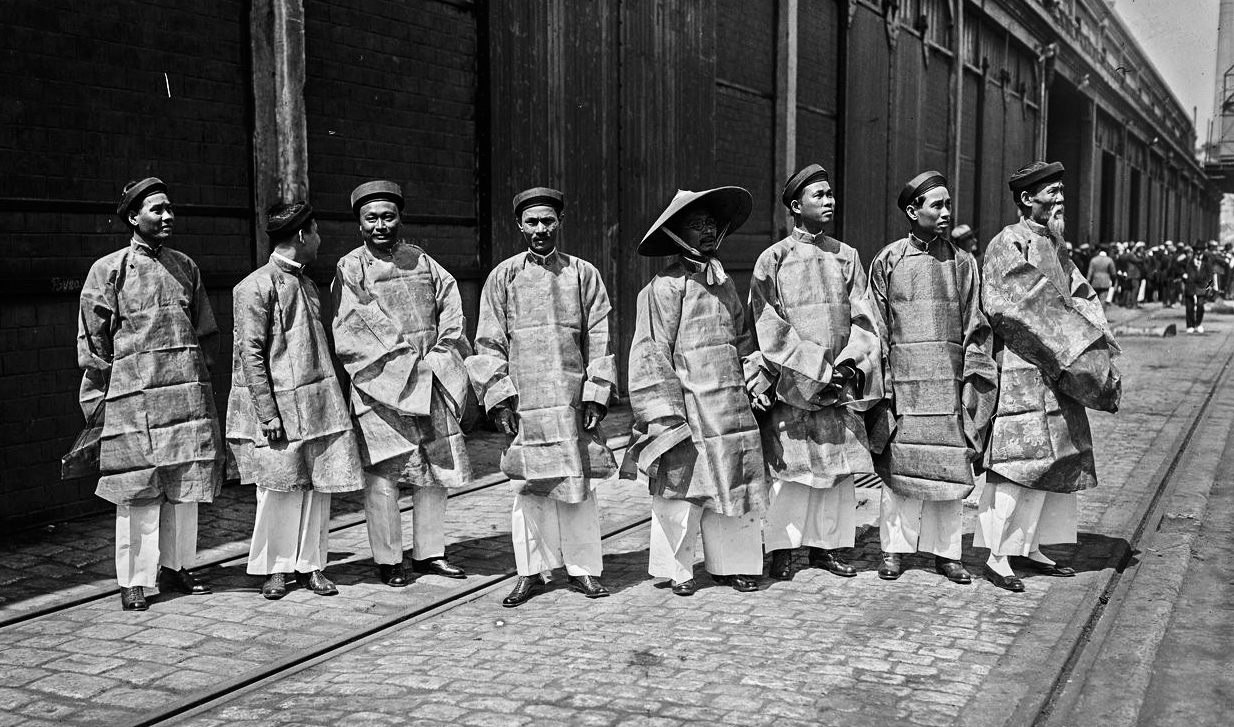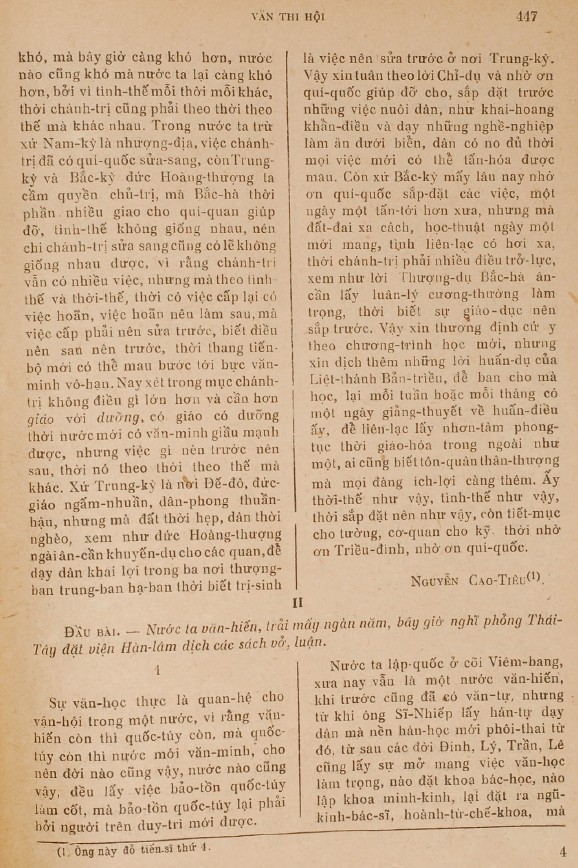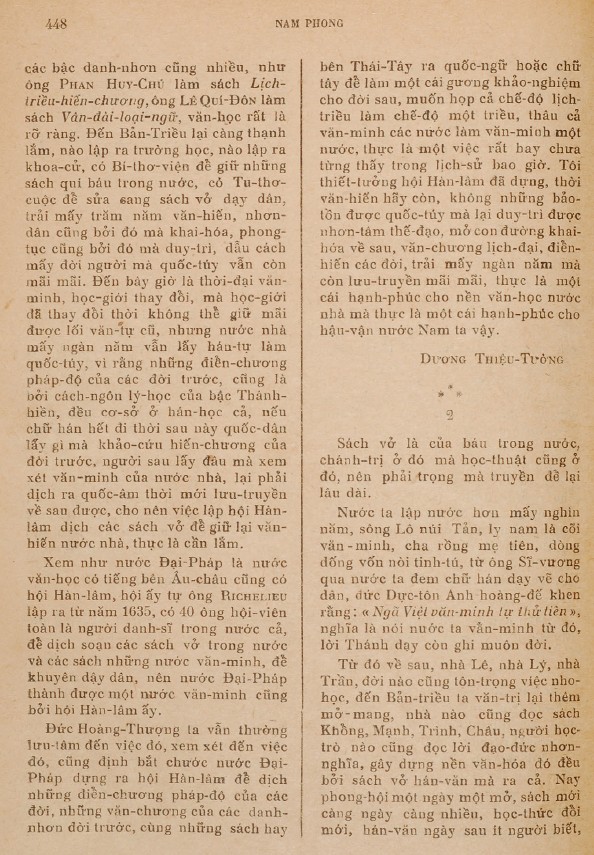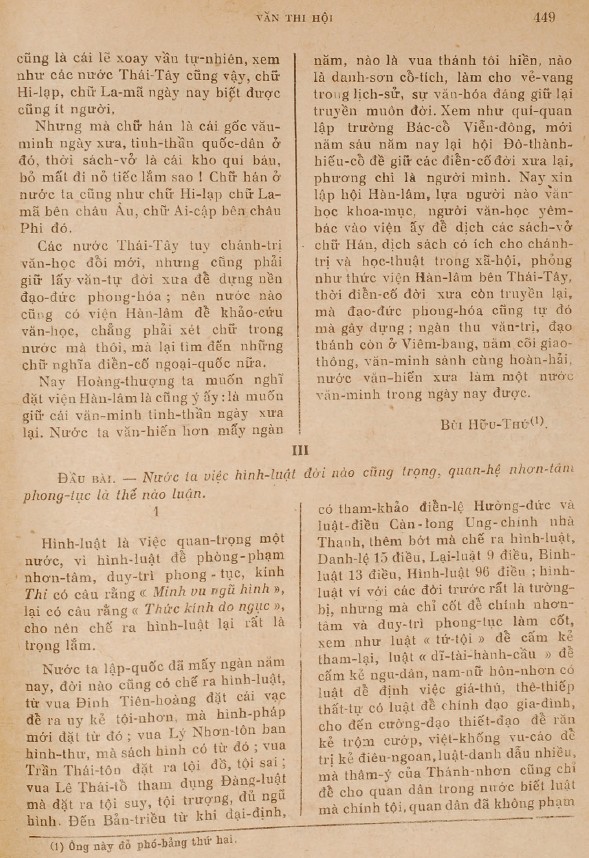Năm 1920 có thể coi là năm bản lề cho sự thay đổi của Việt Nam.
Ở một hướng nghiên cứu khác với Liam, mình cũng đưa ra thời điểm tương tự, là thập niên 1910.
Còn đang viết dở. Nhưng một phần của nó thì đã có thể thấy một chút qua phân tích liên quan đến Cao Đài (đã công bố từ 2014 và gần đây, tạm xem ở đây). Chưa kịp nói đến trong bài về chữ Nôm mới công bố gần đây, vì không có đủ diện tích giấy do phải hạn chế về số chữ của bài (bài về chữ Nôm tạm xem bản trên mạng ở đây).
Dưới là bài của Liam qua bản lược dịch của Nguyễn Hồng Phúc.
---

Trong kỳ thi khoa cử cuối cùng được tổ chức tại Huế năm 1919, đã có những câu hỏi được ra cả dưới dạng Hán văn lẫn tiếng Việt hiện đại ( dùng mẫu tự Latin, quốc ngữ). Một trong số những câu hỏi đó như sau:
“Nước ta văn- hiến trải mấy ngàn năm, bây giờ nghĩ phỏng Thái- Tây đặt viện Hàn- Lâm dịch các sách vở, luận.”
Và trong bài luận của mình, học giả Dương Thiệu Tường đã viết:
“Đến bây giờ là thời- đại văn- minh, học- giới thay đổi, mà học- giới đã thay đổi thì không thể giữ mãi được lỗi văn- tự cũ, nhưng nước nhà mấy ngàn văn vẫn lấy hán- tự làm quốc- túy, vì rằng những điển- chương pháp- dộ của các đời trước, cũng là bởi cách- ngôn lý- học của bậc Thánh- hiền, đều cơ- sở ở hán- học cả, nếu chữ hán hết đi thời sau này quốc- dân lấy gì mà khảo- cứu hiến- chương của đời trước, người sau lấy đâu mà xem xét văn- minh của nước nhà, lại phải dịch ra quốc- âm, cho nên việc lập hội Hàn- Lâm dịch các sách vở đề giữ lại văn- hiến nước nhà, thực là cần lắm.”

Hãy cùng dừng lại và suy nghĩ về điều này. Năm 1919, một học giả ở cấp bậc cao nhất trong hệ thống giáo dục khoa cử, một thiết chế đóng vai trò quan trọng trung tâm học giáo dục truyền thống Việt Nam, đã viết một câu trả lời cho câu hỏi bằng quốc ngữ và tuyên bố rằng thế giới giờ đã thay đổi, thế giới truyền thống của Việt Nam không phải là một phần của cái thế giới mới đó.
Điều này đem đến những gợi dẫn quan trọng cho cách hiểu của chúng ta về lịch sử Việt nam đầu thế kỷ XX. Cái cách mà lịch sử giai đoạn đó vẫn được kể (ít nhất trong các công trình bằng tiếng Anh) là thế giới truyền thống gần như đã mất hết tính chính thống và sự ảnh hưởng của nó ở Việt Nam với sự bất lực của triều Nguyễn trong việc chống lại chủ nghĩa thuộc địa và sự xâm lược của người Pháp.
Câu chuyện sau đó tiếp tục nói về những nhà cách mạng và những nhà cải cách, những người xuất hiện với những nỗ lực nhằm thực hiện những gì mà các quan chức nhà Nguyễn đã thất bại. Ở đây, chúng ta biết đến Phan Bội Châu, Phan Chu Trinh và Đông Kinh Nghĩa Thục, nhưng chúng ta sau đó cũng biết được rằng, nỗ lực cải cách xã hội Việt Nam này đã kết thúc vào năm 1908-1909 khi trường Đông Kinh bị đóng cửa, Phan Chu Trinh bị bắt còn Phan Bội Châu bị ép phải sống lưu vong.
Đến thập kỷ tiếp theo… ‘không nhiều thứ xảy ra’, và chỉ đến cuối những năm 1910 khi Toàn quyền Albert Sarraut đề ra một vài cải cách, người Pháp bắt đầu thành lập hệ thống trường học bao gồm chương trình học quốc ngữ và Pháp ngữ, kèm theo đó là rất nhiều sách báo quốc ngữ được xuất bản, đến khi ấy thì ‘mọi thứ mới thực sự thay đổi’.
Nói một cách khác, lịch sử Việt Nam đầu thế kỷ XX như nó vẫn đang được kể ngày nay là một câu chuyện về những nhà cách mạng Việt Nam và các quan chức thuộc địa người Pháp.
Tuy nhiên, đây là hai nhóm người với số lượng rất ít. Ảnh hưởng của họ có thực sự to lớn đến vậy sao? Hay liệu chúng ta có đang bỏ qua những điều mà những người khác đã làm trong suốt giai đoạn này?

Tuy vậy, những gì được ghi chép từ kỳ thi khoa cử và còn lại của triều Nguyễn cho thấy, ‘rất nhiều thứ’ đã xảy ra trong khoảng những năm 1910. Trên thực tế, toàn bộ thế giới quan [của người Việt?] đã thay đổi.
Sự chuyển dịch từ phát ngôn bằng Hán văn năm 1910 rằng Kinh Dịch là nguồn gốc của mọi tri thức cho đến lời bàn luận bằng quốc ngữ năm 1919 rằng một Hàn Lâm viện nên được mở ra để dịch Hán văn sang quốc ngữ cho thế hệ tương lai có thể tiếp cận được nền Hán học quốc túy của Việt Nam…là một chuyển dịch lớn lao.
Vì vậy, tôi nghĩ ‘câu chuyện’ của lịch sử Việt Nam đầu thế kỷ XX cần được xem xét lại. Phan Bội Châu đã không làm thay đổi được Việt Nam đầu thế kỷ XX, và cả Albert Sarraut cũng khó có thể nhận công trạng cho những gì đã diễn ra vào những năm 1920 tiếp đó.
Thay vào đó, chính giới tinh hoa truyền thống đã tự thay đổi họ, và họ cũng nỗ lực để tạo nên những thay đổi trong xã hội, như những tác phẩm của Phạm Quang Sán đã ghi nhận.
Thêm nữa, rất nhiều trong số những cải cách này đã được chuẩn bị hàng thập kỳ trước những năm 1920, thời đại mà các sử gia hiện đại cho là ‘thời đại của những thay đổi thực sự’ trong lịch sử hiện đại Việt Nam. Học sinh đã được học bằng ký tự Latin,đã biết được rằng thế giới thì tròn và đâu đó trên hành tinh này có khoảng 200 ngọn núi lửa. (xem post trước)

Sau cùng, câu chuyện đang tồn tại trên về lịch sử đầu thế kỷ XX của Việt Nam được định hình bởi [rào cản] ngôn ngữ và những thiên kiến nào đó. Phan Bội Châu quan trọng vì một vài trong số những sáng tác của ông ta đã được dịch sang tiếng Việt hiện đại và các sử gia hiện đại đề cao nỗ lực của ông ta trong tổng thể những nỗ lực của chính họ nằm tạo nên một tự sự về cách mạng Việt Nam hiện đại.
Những cải cách của Albert Sarraut và sự rung chuyển của đời sống tri thức những năm 1920 đã trở thành trọng tâm trong rất nhiều công trình của các sử gia hiện đại, đơn giản vì nguồn tài liệu cho giai đoạn đó đa phần được viết bằng tiếng Việt và tiếng Pháp- những ngôn ngữ mà họ có thể đọc.
Tuy nhiên, dấu hiệu cho những biến chuyển to lớn mà tôi đang nói đến lại chủ yếu nằm trong những tài liệu Hán văn, thứ ngôn ngữ mà các sử gia hiện đại không đọc được.
Về những thiên kiến, nói về các cuộc cách mạng của Việt Nam [cũng là một cách] để ủng hộ cho cái nhìn dân tộc chủ nghĩa vào quá khứ, và thảo luận về những chính sách của người Pháp có gốc rễ sâu xa từ hướng tiếp cận Âu tâm luận đối với lịch sử Việt Nam.
Cả hai hướng tiếp cận trên đều lược bỏ vị trí của nhà Nguyễn như một triều đại thiếu hiệu quả và không quan trọng. Tuy nhiên, cả hai cách tiếp cận này lại có chung một động cơ khi tạo ra sự lược bỏ ấy, đó là nhằm mục đích đề cao tính chính thống của họ.
Nhưng điều gì sẽ xảy ra nếu chúng ta đánh giá một cách đúng mức cẩn thận về vai trò của nhà Nguyễn, và nếu chúng ta cố gắng để đọc những văn bản mà giới trí thức triều đó để lại?
Tôi nói chỉ ra rằng, khi chúng ta làm điều đó, cách hiểu của chúng ta về Việt Nam đầu thế kỷ XX sẽ thay đổi. Vâng, đã có những nhà cách mạng Việt Nam và những quan chức người Pháp, nhưng cũng có cả những người thậm chí là với số lượng rất lớn các ‘học giả truyền thống’ đã tự mình thay đổi để trở thành những ‘trí thức hiện đại’, và họ cũng đã có những cố gắng hướng giới trẻ Việt Nam theo những thay đổi ấy.
Và tất cả những điều này đều đã được chuẩn bị trước khi những năm 1920 bắt đầu, thời điểm diễn ra những cuộc thay đổi thực sự.
Nguồn: Rethinking the History of Early-Twentieth-Century Vietnam by Liam Kelley, 5/11/2016. Nguyễn Hồng Phúc lược dịch ngày 10/11/2016.
https://nguyenhongphucwriting.wordpress.com/2016/11/10/liam-kelley-nghi-lai-ve-lich-su-viet-nam-dau-the-ky-xx/

When the final palace exam was held in Huế in 1919, there were questions in both classical Chinese and modern Vietnamese (using the Latin script, chữ quốc ngữ). One of the questions in Vietnamese asked the following:
“Our country has been one of literary civility for thousands of years. Should we now follow the Occident and establish a National Academy to translate books? Discuss this.”
And in his discussion of this question, scholar Dương Thiệu Tường said the following:
“The present is an age of civilization and the world of scholarship has changed. And with this change in the world of scholarship it is not possible to maintain the old writing, but for thousands of years the country has taken Hán characters as its national essence [quốc túy]. . .
“If Hán characters disappear then how will the citizens in the future be example to examine the documents from the past? What will later people be able to find to see the civilization of the country? We have to translate [writings in classical Chinese] into the national language as that is the only way that they can be preserved for the future. Therefore establishing an Academy of Sciences to translate books and preserve the literary civility of our country should definitely be done.”

Let’s stop and think about this. In 1919 a scholar at the highest level of the civil service examination system, an institution that was of central importance for traditional education in Vietnam, wrote an answer to a question in vernacular Vietnamese using the Latin script and declared essentially that the world had changed and that the traditional world of Vietnam was not part of that new world.
This has significant implications for our understanding of early twentieth century Vietnam. The way that the history of the early twentieth century has been told (at least in works in English) is that the traditional world essentially lost its legitimacy and its influence in Vietnam with the Nguỹen Dynasty’s inability to resist French conquest and colonialism.
This story goes on then to talk about revolutionaries and reformers who appeared in an effort to accomplish what Nguyễn Dynasty officials had failed to do. Here we learn about Phan Bội Châu and Phan Chu Trinh and the Tonkin Free School (Đông Kinh Nghĩa Thục 東京義塾), but then we also learn that this revolutionary effort to reform Vietnamese society came to an end by 1908-09 as the Tonkin Free School was shut down, Phan Chu Trinh was arrested and Phan Bội Châu was forced to live in exile.
Then for the next decade. . . “not much happens,” and it’s only at the end of the 1910s when Governor-general Albert Sarraut implements some reforms and the French start to set up a school system that includes education in vernacular Vietnamese (using the Latin script) and French, and journals in vernacular Vietnamese start to get published, that “things really started to happen.”
In other words, the history of early twentieth century Vietnam as it is told today is a story about Vietnamese revolutionaries and French colonial officials.
However, those are two very small groups of people. Was their influence really that great? Or are we ignoring what other people did during this period?

What documents from the civil service exams and the world of the Nguyễn Dynasty show, however, is that “a lot” happened in the 1910s. In fact, an entire worldview was transformed.
The change from declaring in classical Chinese in 1910 that the Classic of Changes (Yijing 易經) is the source of all knowledge to arguing in vernacular Vietnamese in 1919 that a National Academy should be established to translate texts from classical Chinese into modern Vietnamese so that future generations will be able to access the national essence of Vietnam – classical Chinese learning. . . that is a massive transformation.
Therefore, I think “the story” of early twentieth century Vietnamese history needs to be reconsidered. Phan Bội Châu did not transform early-twentieth-century Vietnam, nor can Albert Sarraut take credit for what happened in the 1920s.
Instead, the traditional elite transformed themselves, and they also made efforts to transform society, as the writings of Phạm Quang Sán indicate.
What is more, many of those transformations had been underway for a decade before the 1920s began, the time that modern historians regard as a “real time of change” in modern Vietnamese history. Students had already studied the Latin script, and had already learned that the world is round and that there are somewhere around 200 volcanoes on the planet. (see the previous post)

Ultimately the existing story of the history of early-twentieth-century Vietnam takes the form it does because of language and because of certain biases. Phan Bội Châu is important because some of his writings have been translated in to modern Vietnamese and modern Vietnamese historians have highlighted his efforts in their own effort to create a “revolutionary” narrative of modern Vietnamese history.
Albert Sarraut’s reforms and the vibrancy of intellectual life in the 1920s have been the focus of the work of many modern historians as the sources for that period are in modern Vietnamese and French, languages that modern historians have the ability to read.
The evidence for the “great transformation” that I am talking about here, however, is largely in classical Chinese, a language that most modern historians do not read.
As for biases, talking about revolutionaries supports a Vietnamese nationalist view of the past, and discussing French policies has its roots in a Eurocentric approach to Vietnamese history.
Both the Vietnamese nationalist and Eurocentric approaches to the Vietnamese past dismiss the Nguyễn Dynasty as ineffective and unimportant. However, both of those approaches have a motive for dismissing the Nguyễn Dynasty, as doing so enhances their legitimacy.
But what happens if we take the Nguyễn Dynasty world seriously, and if we make the effort to actually read the documents that intellectuals from that world left behind?
I would argue that when we do that, our understanding of early-twentieth-century Vietnam changes. Yes, there were Vietnamese revolutionaries and French officials, but there was an even larger world of “traditional scholars” who transformed into “modern intellectuals” and who sought to get the youth of Vietnam to undergo the same transformation.
And all of this was well under way by the 1920s, the time when “things really started to happen.”

Không có nhận xét nào:
Đăng nhận xét
Khi sử dụng tiếng Việt, bạn cần viết tiếng Việt có dấu, ngôn từ dung dị mà lại không dung tục. Có thể đồng ý hay không đồng ý, nhưng hãy đưa chứng lí và cảm tưởng thực sự của bạn.
LƯU Ý: Blog đặt ở chế độ mở, không kiểm duyệt bình luận. Nếu nhỡ tay, cũng có thể tự xóa để viết lại. Nhưng những bình luận cảm tính, lạc đề, trái thuần phong mĩ tục, thì sẽ bị loại khỏi blog và ghi nhớ spam ở cuối trang.
Ghi chú (tháng 11/2016): Từ tháng 6 đến tháng 11/2016, hàng ngày có rất nhiều comment rác quảng cáo (bán hàng, rao vặt). Nên từ ngày 09/11/2016, có lúc blog sẽ đặt chế độ kiểm duyệt, để tự động loại bỏ rác.